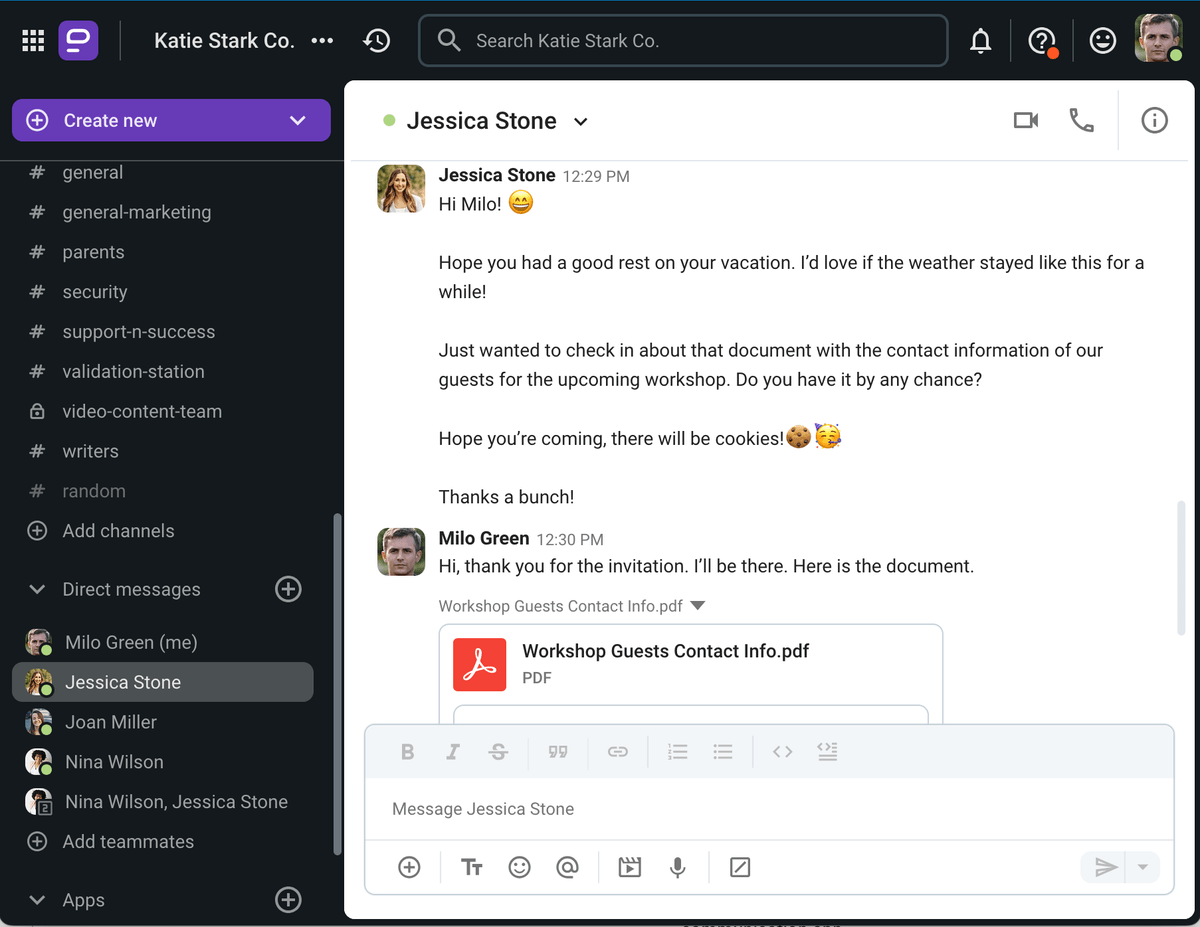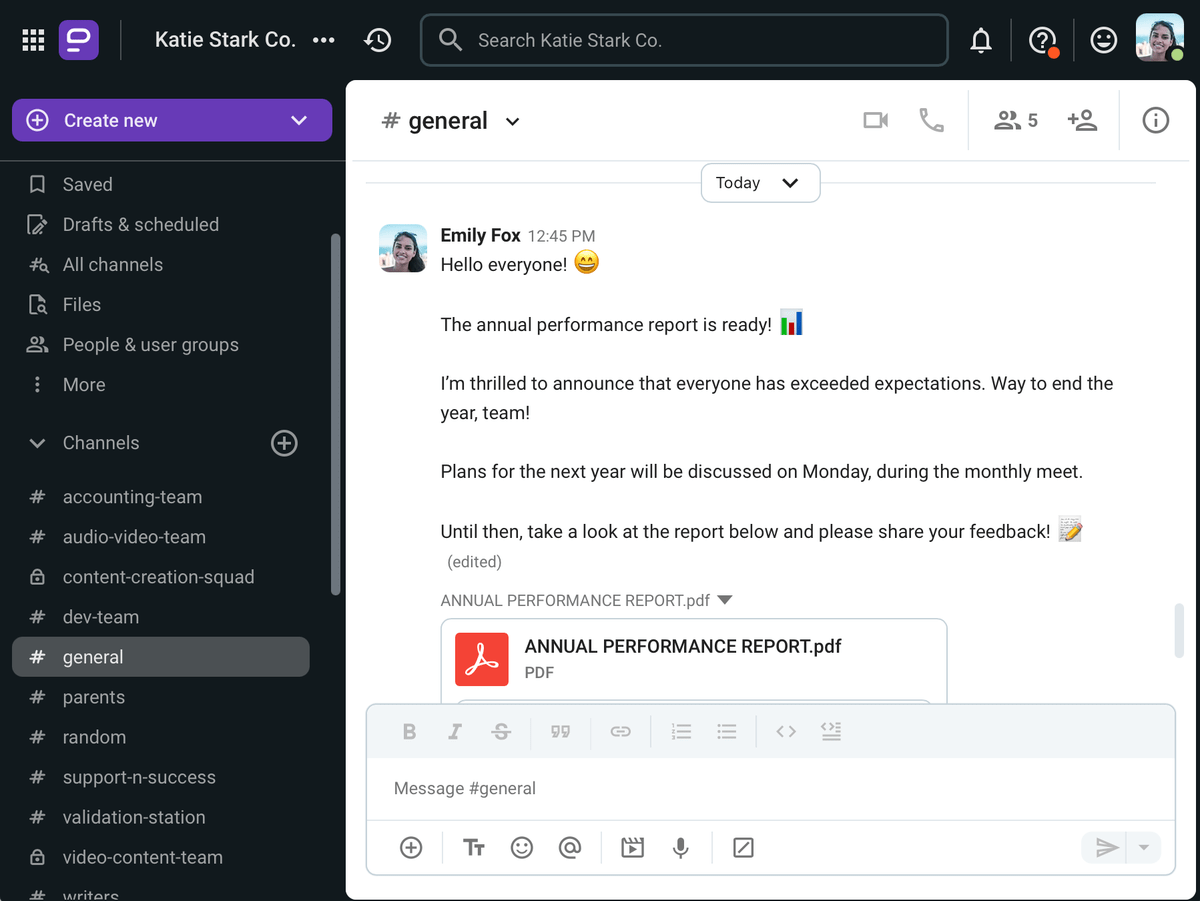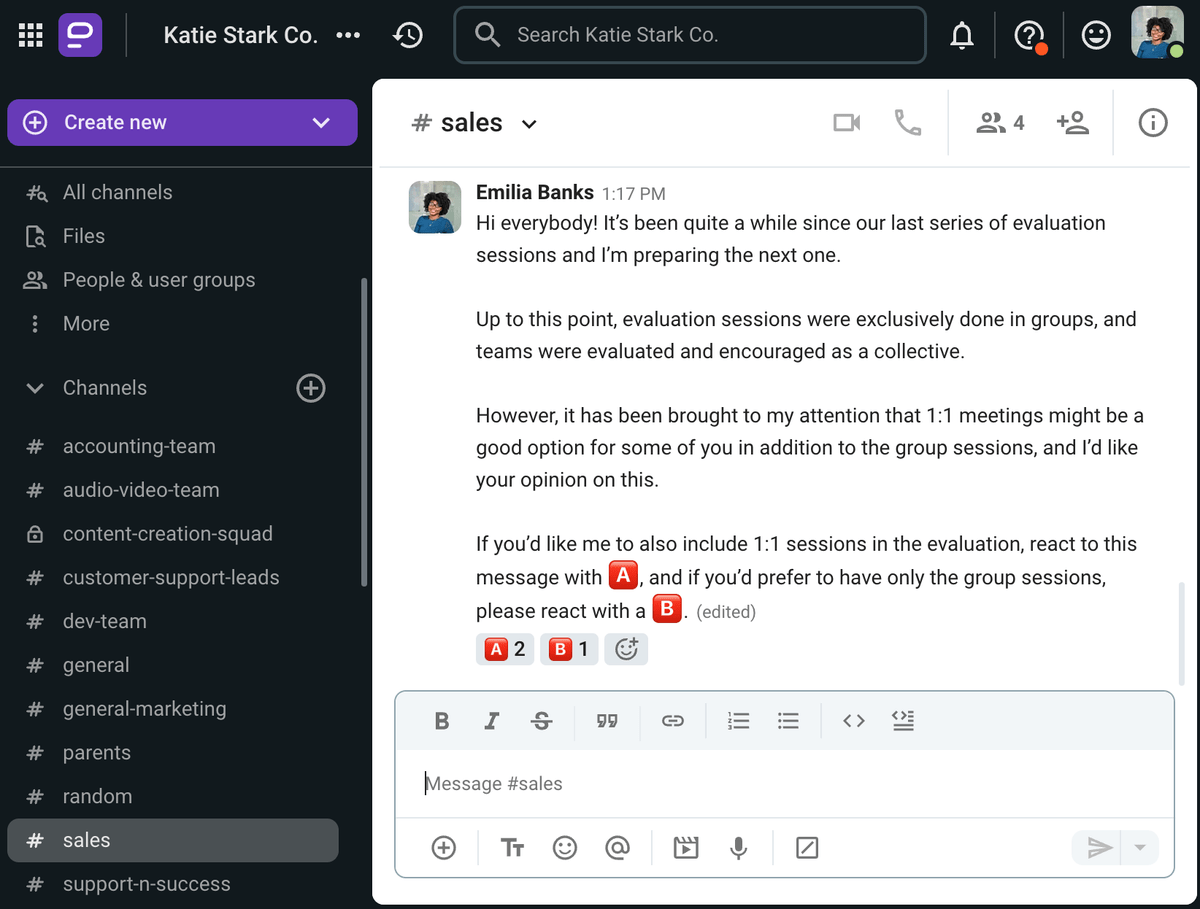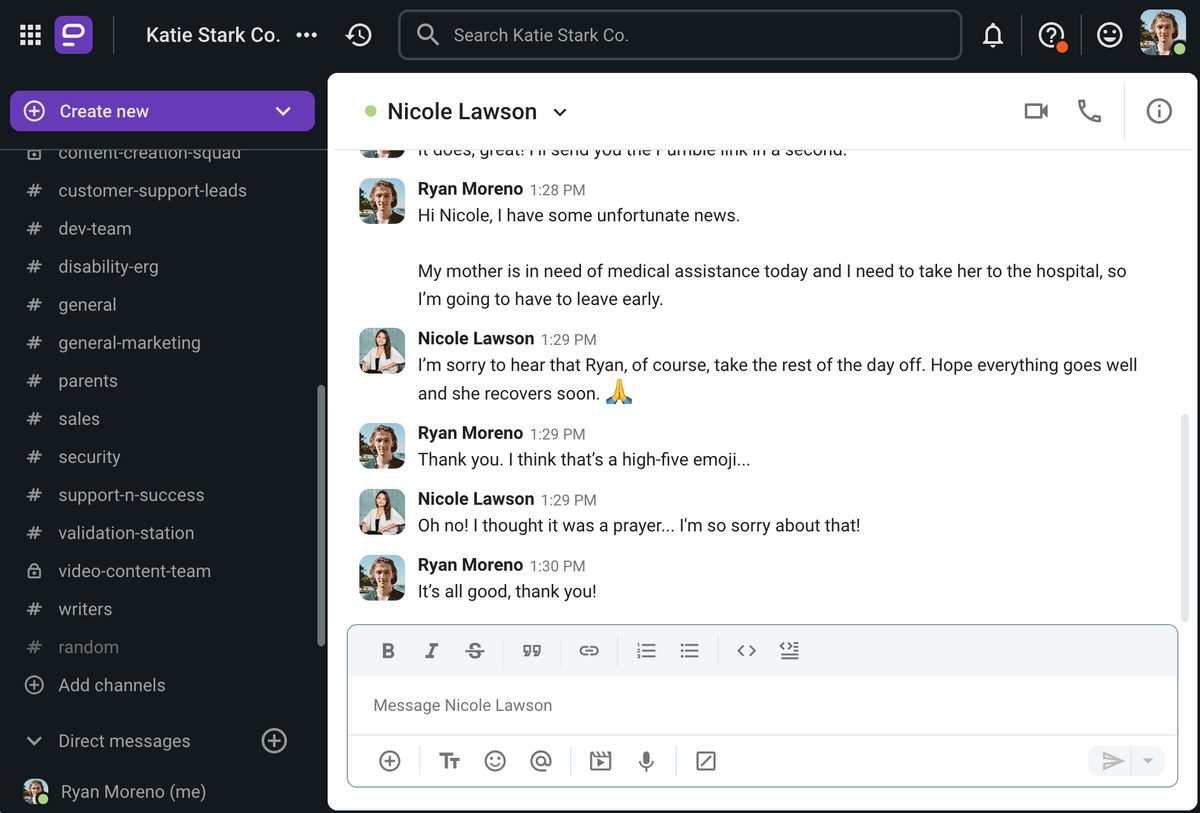At first glance, the communication process seems simple enough, right?
You say a few words to your interlocutor, they understand what you mean and give you a prompt response.
But, that’s not always the way things go. Say that a joke you make falls flat, and you have to think of ways to redirect the conversation. Or, you use the word “bike” to talk of your love of cycling, but your interlocutor thinks you’re talking about motorbikes.
These issues occur because the communication process is ever-changing and depends on 8 interconnected factors.
In the following sections, we’ll explain the process of communication, each of its factors, and the importance of the communication process.
We’ll also hear from experts who’ll share some of their tried-and-true tips on improving the communication process and eliminating miscommunication.
Without further delay, let’s jump in.

What is the communication process?
The communication process encompasses a sequence of acts necessary for effective communication. These acts ensure the successful transmission of meaning between at least 2 participants, helping them understand each other without issues.
However, while the communication process is a comprehensive and reliable tool that can help achieve successful communication between 2 or more people, it sometimes isn’t as straightforward as it first appears.
In reality, effective communication requires careful attention to the 8 interconnected elements that make up the communication process. When properly followed, the communication process can ensure the intended message is conveyed and understood without misinterpretation or confusion.
But, this requires a deep understanding of the process and active participation. Let’s discuss the communication process and its formative elements.
What are the elements of the communication process?
In the book The Process of Communication: An Introduction to Theory and Practice, American communication theorist David K. Berlo writes:
“With the concept of process established in our minds, we can profit from an analysis of the ingredients of communication, the elements that seem necessary (if not sufficient) for communication to occur.”
When Berlo mentions the “concept of process,” he references the fact that communication, like other processes, is dynamic and ever-evolving.
Take the conversations you have with your coworkers as an example. The topic changes depending on whom you’re speaking to, as do your tone of voice and body language.
But, some ingredients remain the same with each interaction — the 8 elements of the communication process. These are:
- Source,
- Message,
- Channel,
- Receiver,
- Feedback,
- Environment,
- Context, and
- Interference.
We’ll now examine these elements in greater detail.
Element #1: Source (Sender)
In the process of communication, the source or sender is the person who speaks in order to create and impart a specific message to their audience.
The source may convey their message using verbal language but also through their:
- Body language,
- Clothing, and
- Tone of voice.
According to Berlo, communication is virtually impossible without a source:
“We can say that all human communication has some source, some person or group of persons with a purpose, a reason for engaging in communication.”
Before speaking or writing, the source has to decide what they want to convey and how they wish to format their message.
Then, the source encodes the message using words and putting them in a specific order to achieve the desired meaning. Only after taking these steps can a source deliver the message to the audience.
Element #2: Message
The message is the source’s purpose of communication, and during the communication process, the source converts this purpose into speech or text.
In The Basics of Speech Communication, Scott McLean describes the message as “the stimulus or meaning produced by the source for the receiver or audience.”
McLean also emphasizes that the message is more than words strung together by order and grammatical rules. How we format and transmit our message depends on the type of communication we intend to engage in.
For instance, in written communication, you can change and reshape a message through:
- The use of emojis,
- The addition of subheadings,
- Adjustments in writing style, and
- Formatting the message.
And, as we’ve mentioned, your appearance and body language during in-person meetings or video conferencing calls can also affect how you communicate your message.
But, there’s more to it.
Our environment and the context we provide can imbue the message with additional meaning. On the other hand, noise can obscure our intended meaning during the interaction and become a communication barrier.
Element #3: Channel
The channel is the manner by which the message travels from the source to the receiver.
In his examination of communication models, Berlo touches on channels, stating that:
“A channel is a medium, a carrier of messages. It is correct to say that messages can exist only in some channels; however, the choice of channels often is an important factor in the effectiveness of communication.”
Here’s a good example of that — let’s take a look at the streaming services you’re subscribed to. They are all separate channels and they all combine visual and auditory information to communicate a specific message. When you look away from the screen, you can still hear the program and gather enough clues to understand what’s going on.
The same goes if you lower the volume. Thanks to subtitles and visual cues, you’ll still be able to follow the plot without much trouble.
A similar scenario happens in real-time communication. Depending on our purpose and needs, we can choose from several different channels, which could include:
- Voice and video calls,
- Direct messaging in a business communication app,
- Voice messages, and
- Emails.
🎓 Pumble Pro Tip
For a deeper look into communication channels and information about which channels are suitable for different kinds of communication, see this guide:
Element #4: Receiver
As the name suggests, the receiver is the person whose task is to receive the source’s message.
The receiver is just as important as the source in the communication process because their actions can make or break the interaction.
No matter how carefully you choose your words, the communication situation may go awry, as you have no control over how the interlocutor:
- Interprets the message,
- Behaves after hearing the message, or
- Uses their cultural experience and knowledge to participate in communication.
The above points determine whether the receiver will choose to provide feedback to the source and actively participate in the communication action. No further communication can occur if the receiver decides not to respond and withholds feedback.
Keep in mind that a receiver may not always respond using verbal messages.
For example, if you are speaking at a business summit attended by more than 200 people, you’ll feel the audience sizing you up. Although the attendees won’t voice their opinion on what you’re saying, you can modify your performance and add more information to your message by watching the reaction of audience members.
Element #5: Feedback
Feedback is the response the receiver returns to the source.
It may be:
- Unintentional or intentional and
- Nonverbal or verbal.
Feedback is vital in letting the source know how the receiver has interpreted the message.
Another important function of feedback in communication is to give the receiver the chance to:
- Request additional information or clarification,
- Support or object to the source’s claims, and
- Inform the source how to modify their approach.
The role feedback plays in the communication process cannot be overstated.
In the research article Some effects of feedback on communication, Mueller and Leavitt detailed the result of an experiment that dealt with how different levels of feedback affected communication. Their conclusion was that:
“Increasing feedback resulted in increasing [communication] accuracy.”
🎓 Pumble Pro Tip
Feedback is instrumental in professional communication, and so is feedforward. To learn more about how the two concepts are related and how to use them to your advantage, read this blog post:
Element #6: Environment
The environment refers to the mental and physical contexts in which we communicate, both as the sender and the receiver of messages. It encompasses the setting, atmosphere, and conditions that may influence the interpretation and reception of information.
For example, if you’re in a conference room, your environment might include:
- Tables,
- Chairs,
- Laptops,
- Windows, and
- A whiteboard.
Psychological aspects of the environment may include whether the topic is discussed in a transparent manner and whether the communication is formal or informal.
Element #7: Context
While some confuse context for the environment when talking about the communication process, context refers to the:
- Scene,
- Setting, and
- Expectations of the conversation participants.
For example, when you head into the office, you expect those present to be smartly dressed and speak and act in a specific way. Thus, anyone wearing a T-shirt and shorts would stick out like a sore thumb.
That’s because context dictates how formal or informal the environment should be.
During work meetings, someone’s position and expertise affect when and how they will speak, as well as what they will speak about. During short breaks, everyone is free to quickly catch up or talk about informal topics. But, when the meeting resumes, all off-topic conversations cease.
🎓 Pumble Pro Tip
As a crucial element of the communication cycle, context is also vital in cross-cultural communication. Namely, the cultural context we inherit and learn through experience affects how we convey messages. For more information on cross-cultural communication and cultural context, check out this detailed blog post:
Element #8: Interference (Noise)
The final component of the communication process, interference, is also sometimes called noise.
Interference or noise can be anything that distorts or modifies the intended meaning of a message.
If your desk is by the window, you likely see billboards and commuters and hear traffic sounds. This noise can halt your stream of thought or interrupt a conversation with coworkers.
However, in the communication cycle, the noise could also be psychological.
Although you work in a quiet environment, your own thoughts could block you from fully listening to what someone is saying. For instance, if your superior hasn’t finished talking to you, but you are already coming up with what to say in return, chances are you’ve missed a few points.
Similarly, if you forgot to drink water before joining a meeting, you may pay more attention to the water cooler than the presentations.
🎓 Pumble Pro Tip
Unfortunately, the modern workforce is rife with distractions that act as communication hurdles. The occasional pinging from your team messaging app may prevent you from giving your all to the task at hand. If you’ve struggled with this in the past, take a look at this helpful post:
And, to learn how to deal with general distractions that often plague our work environments, check out this post:
How does the communication process work?
There are 5 steps in the communication process. They are:
- Idea formation,
- Message encoding,
- Message transmission,
- Message decoding, and
- Feedback.
The following model is also known as the transactional model of communication. Breaking down these communication cycle phases will help you better understand your role in conversation and improve your communication skills.

Step #1: The source or sender has an idea (Idea formation)
Communication begins with the source, the person who thinks of and sends the message.
Several things can influence the message a source wants to convey, including their:
- Culture,
- Mood,
- Background, and
- Context of the communication situation.
For example, how you greet a coworker depends on:
- Your mood,
- Their position within the company,
- Your own culture, and
- Your knowledge of your coworker’s culture.
Consequently, before saying or writing anything, you have to consider the above factors to prevent misinterpretation and confusion.
Moreover, a source should always think about how the receiver or audience will respond to the message. One of the most invaluable skills an effective communicator can hone is the ability to adapt their message so that it elicits a positive response from the interlocutor.
Step #2: The source encodes the idea in a message (Encoding)
Encoding is the second step in the process of communication. This phase consists of transforming an idea into gestures and words that will successfully carry its meaning to the receiver.
However, encoding can be a challenging task, as different people associate different meanings with the same words.
According to Guffey and Loewy in Business Communication: Process & Product, miscommunication that stems from mismatched meanings is called bypassing, and it is one of the most common pitfalls of professional communication.
To avoid these complications, skilled communicators should strive to use familiar words because the goal is to have the source and receiver agree on their meanings.
However, just because you and your coworkers share a language doesn’t mean you share the same business culture, too.
Take a look at the Pumble exchange below to see how language and culture can clash.

Jessica has sent a message to Milo, the new administration officer who has moved to the US from the UK. Jessica starts with casual chit-chat before diving into the point of her message.
While that is considered polite behavior in the US, it can grate on people from countries where it is customary to get to the point without veering off-topic.
Furthermore, Jessica uses the terms “vacation” and “cookies.” While these don’t throw Milo off, in the UK, it’s common to hear “holiday” or “biscuits”.
Finally, Milo’s response is brief and doesn’t venture into non-work-related territory.
Step #3: The message is transmitted via a communication channel (Transmission)
During the communication cycle, it is necessary to find the best way to physically transmit the message to the receiver. The transmission medium is the channel, and we can share messages via:
- Web pages,
- Emails,
- Podcasts,
- Blogs,
- Business messaging apps,
- Announcements,
- Reports,
- Phone calls,
- Pictures, and
- Memorandums.
Deciding on the most effective channel is imperative because it can affect how a receiver interprets both verbal and nonverbal messages.
For instance, in the example below, Emily is sharing the annual performance report with her colleagues. How they receive the message will depend on:
- The tone present throughout the report,
- The document’s layout, and
- The inclusion of graphics and charts.

Of course, before picking the most effective channel, the source must consider the noise and how it could interfere with the communication process.
As we’ve discussed, anything that obstructs the communication cycle is considered noise.

These interferences may take many forms, from misspellings in business emails to poor connection during a virtual video call. However, choosing an unsuitable time to send an email or scheduling a team meeting for a simple update can also be an interference.
Step #4: The receiver decodes the message (Decoding)
An essential phase of the communication cycle — decoding — occurs when the receiver analyzes the message and converts its symbols to uncover the intended meaning.
Successful communication can only happen when the receiver cracks this code — that is, when they comprehend what the source intended to say.
But, achieving effective communication is easier said than done because no 2 people share the same experiences and knowledge. Moreover, numerous communication barriers can get in the way of decoding and halt the entire process.
Some factors that undermine decoding messages can be internal, and these include:
- A lack of attention when someone is speaking and
- Pre-existing cognitive biases and prejudice towards the source.
External factors can also impede the communication process. For example, it might be hard to decipher someone’s words in a loud environment, and misunderstandings are bound to happen.
However, semantic hurdles can cause severe communication issues in a professional setting. For example, let’s analyze the announcement below.

John has posted what he thinks is an exciting announcement about an upcoming company event. While his intentions may have come from the right place, his words have definitely missed the mark.
His choice to refer to new hires as “newbies,” the female employees as “girls,” and seasoned employees as “oldtimers” has the potential to offend part of the workforce.
Thus, these word choices could lead to strong reactions that prevent the employees from focusing on the overall message.
Step #5: Feedback reaches the source
Feedback is the backbone of communication and covers the interlocutor’s nonverbal and verbal responses. These signals let the source know how someone has received and understood the message.
For example, when a coworker asks, “How’s your day going?” you can respond with, “Good, thanks. And yours?”.
Or, if you’ve had a particularly draining day, you might smile and shrug your shoulders.
The same goes for using team communication apps. You can:
- Send a message,
- Post a comment, or
- Use an emoji to show how you feel.
Of course, different people share varying degrees of feedback, which is why it’s a good idea to encourage feedback with questions like:
- “Is everything I’ve said clear?”
- “Do you need clarification on anything I’ve mentioned?”
Remember that overwhelming the receiver with too much information may confuse them and thus lead to a lack of feedback.
Think of your delivery, time it appropriately, and give the interlocutor enough time to organize their thoughts.
Additionally, it’s essential to differentiate between 2 types of feedback:
- Evaluative feedback and
- Descriptive feedback.
Evaluative feedback doesn’t reflect whether the receiver has understood the source. Instead, it is often judgemental and can push the source into defensiveness.
On the other hand, descriptive feedback results from the receiver understanding the intended meaning of the source’s message.
For example, saying, “I see how the numbers suggest we should focus more on inbound marketing in the next quarter,” is better than stating, “These numbers don’t look too good.”
The first response invites others to become active in the conversation, while the second acts as more of a deterrent.
🎓 Pumble Pro Tip
Do you want to become better at giving and requesting constructive feedback? If that’s the case, head to the blog posts below:
Tips for improving the communication process
Now that we’re familiar with the elements and the 5 steps of the communication process, we can focus on learning how to ensure the best possible outcomes.
Tip #1: Beware of bypassing
Business communication is complex, and unless you’re careful, bypassing could become a common occurrence.
Bypassing is a phenomenon that happens when the source and receiver attach 2 wholly different meanings to a single word.
For example, if you’ve just landed your first job after graduating from university, seeing “meeting cadence” mentioned in a message from your manager might confuse you.
You may immediately think of the more well-known definition of the word “cadence,” which is the inflection of someone’s voice. But, your manager is referring to the frequency of team meetings, and it could take a while to straighten things out.
The good news is that business communication doesn’t have to be convoluted. You can prevent bypassing if you:
- Avoid using business jargon in the workplace,
- Use simple and clear language, and
- Proofread your messages and emails to eliminate spelling errors and vague wording.
Tip #2: Strive to be a more attentive listener
Even when the source goes to great lengths to neatly package their message, their efforts will go to waste if the interlocutor is a poor listener.
Fortunately, active listening is a skill, and you can learn how to leverage it to your advantage in business communication.
In Communication in Business: Strategies and Skills, Judith Dwyer cites Gamble and Gamble (1996), who have identified 6 common behaviors most poor listeners exhibit.
These disruptive behaviors are:
- Dart thrower: Questioning the speaker and the validity of their story as soon as they make a mistake, no matter how minor it is.
- Ear hog: Dominating the communication situation by pushing your story and preventing others from telling their side.
- Bee: Only listening to parts of the conversation that interest you the most and ignoring everything else.
- Earmuff: Sidetracking the conversation to avoid confronting specific information.
- Gap filler: Coming up with additional information to prove you’ve heard the whole story, although you only zeroed in on parts of it.
- Nodder: Feigning listening by pretending to pay attention to the speaker. In reality, you are thinking about a different topic entirely.
Sometimes, we inadvertently engage in the above behaviors, so it’s essential to join every communication act without preconceived notions and unconscious biases.
According to Joanna Staniszewska, a seasoned marketing, communication and HR professional, communication is a two-way street, and active listening is one of the most effective strategies:

“Actively listening to others fosters trust and understanding. Encourage individuals to pay attention, ask questions, and confirm their comprehension during conversations.”
🎓 Pumble Pro Tip
Do you want to learn more tips on becoming a present and attentive listener? If so, we have just the post for you:
Tip #3: Create an environment that encourages feedback
Establishing stable feedback loops positively impacts employee engagement, creating a safe space for people to self-advocate at work .
A system that compels team members to speak up without reservations in manager-employee relationships is invaluable. It can act both as a channel for employee recognition and resolving conflicts before they snowball into large-scale issues.
Staniszewska mentioned that a stable communication process should rely on sustainable feedback loops:

“Emphasize the need for feedback mechanisms that allow individuals to assess their communication effectiveness continually. This can be formal, like surveys, or informal, like regular team check-ins.”
So, how do you create a positive feedback loop that reinforces the communication process?
You can start by:
- Leading with empathy: Emphasize to others you’re ready to hear them out without prejudice or judgment.
- Giving feedback in person: Face-to-face meetings or video calls often feel more authentic than messages and emails.
- Managing your emotions: Tap into your emotional intelligence and approach each situation with a clear mind.
Here’s an example of how to effectively communicate and create this environment:

When eliciting feedback, remember not to rush the interaction, states Dawid Wiacek, a communication and executive career coach:

“In today’s business landscape, speed is often a competitive advantage, but when it comes to success in communication, one of the keys is actually slowing down. To ensure the other person has digested your message accurately, it’s helpful to ask them to summarize it in their own words.
You can ask what resonated about the message and what didn’t; what they felt was the core element, and what was secondary; what was validating and perhaps surprising. The point here is you want to engage the recipient and make sure that the original message was translated appropriately and not lost in translation.”
Tip #4: Think about where you (and others) come from
Although it can be nerve-wracking, giving feedback to colleagues is part of virtually all jobs.
Ideally, we deliver critiques in a constructive and empowering manner, but that’s not always how things pan out.
That’s not to say we purposely try to offend our coworkers. The situation may simply be a result of cultural differences.
Let’s take the below exchange as an example.

Nicole, who is from the US, sends her well wishes to Ryan, who has been working from Japan for the past 6 years. A minor misunderstanding arises because Nicole assumed Ryan and she would interpret the meaning of an emoji in the same way.
This type of blunder can be funny — Nicole and Ryan were able to clear the air quickly and move on.
But, what would happen in a more serious situation, such as a performance review?
For instance, moving a manager from Germany to take over a department in South Korea can become a disaster if no forethought goes into it. In Korean society and business, respect is determined through a mix of age, experience, and hierarchical position.
Thus, if the German manager is older than part of his Korean staff, they will be less likely to push back against unwarranted criticism. Moreover, after receiving the message from the manager, they could even return disingenuous feedback in an effort to save face.
Fortunately, this doesn’t mean that all cross-cultural collaboration is doomed. However, to successfully communicate, employees should be strategically encouraged to adapt and be mindful of potential differences.
Joanna Staniszewska highlighted the importance of cultural intelligence and sensitivity:

“Communication takes place in diverse environments. Stress the importance of cultural awareness and sensitivity. Encourage individuals to adapt their communication styles to resonate with the audience’s cultural norms and expectations.”
Tip #5: Read up on communication styles
Understanding your preferred communication style and tweaking it to align with your coworkers can make a difference in team collaboration and communication.
When a colleague abruptly shuts down during the communication process, it might not be because of something you’ve intentionally said or done.
Perhaps your personal communication style got in the way, and the person on the other end felt you were disregarding their ideas and opinions. Although you thought you were assertively standing up for your idea, your coworker may have felt like you were subtly attacking theirs.

Changing how you communicate can point you toward professional success, and a good starting point is bolstering your emotional intelligence. Through a combination of social awareness and self-awareness, you’ll gradually gain more control over how you speak and act in the workplace.
In the case that you need more guidance, another strategy would be enrolling in a professional development course that could help you become a more transparent and flexible communicator.
When a communication break occurs, it isn’t always possible to salvage the communication process. However, with the proper education and a dash of commitment, you can learn how to facilitate productive and open conversations.
🎓 Pumble Pro Tip
For more extensive information on different communication styles, as well as becoming more flexible during business communication, check out this guide:
Tip #6: Take into account the changing demographics of the workforce
Another unique issue in workplace communication is learning how to connect and collaborate with colleagues from different generations.
We all have specific habits and preferences, and the generational gap can sometimes put our behavior at odds with that of our older or younger coworkers.

Navigating these differences and refraining from resorting to stereotypes is the way to go when creating a well-connected and inclusive environment.
So, be honest about your preferred ways of communication and respect the boundaries of your team members. As soon as they notice these efforts, they’ll feel more at ease when asking for help or reaching out about a work task.
🎓 Pumble Pro Tip
Are you interested in learning more about enhancing communication across generations within your team or company? Then check out this exhaustive blog post:
Why is the communication process important?
Through the way we communicate, we learn not only how to get ahead in life but also how to form stable relationships.
If you think of life skills as a tower of cards, communication is near the base, laying a solid foundation. Should this card wobble slightly, it will jeopardize the stability of the entire tower.
Moreover, by mastering the communication process, you:
- Readjust your self-perception and how you view the world around you,
- Become a better learner, and
- Learn how to represent both your employer and yourself in the best light.
In the following sections, we will devote more attention to exploring the above three points.
Reason #1: The communication process affects how we view others and ourselves
The phrase “at a loss for words” aptly describes how it feels to come out of a communication situation unsuccessful.
Not only do you feel like you’re missing the right words, but it is as if you’re also missing a vital part of yourself. This unpleasant emotion sprouts because we share a part of our worldview with our interlocutor when communicating. We often inadvertently reveal the reasoning behind our train of thought and how we believe everything fits into this neatly organized snapshot of the world.
And, you go through the same scenario when listening to friends or coworkers. You take in their appearance, facial expressions, and words to form an assumption about what their values and priorities may be.
It’s not always feasible to pick the right words or rein in your facial expressions, but learning how the communication process works does help.
For example, you’ll realize that what you say could reveal just as much about yourself as the topic you are discussing. Thus, rather than simply waiting for your turn to speak, you might make a conscious effort to actively listen and understand the other person’s perspective.
Reason #2: The communication process affects the way we learn
In Business Communication for Success, McLean reminds anyone willing to work on their communication skills that this endeavor will require:
- Effort,
- Persistence, and
- Self-correction.
McLean likens becoming a better communicator to sharpening other valuable life skills. There was a time when you didn’t drive a car or have a clue about digital literacy, yet, over time (and much trial and error), you’ve become a much more capable person.
So, while results won’t come overnight, and you might get tangled up in a few difficult conversations at work, the effort is worth it. The key is to keep talking and listening. Soon enough, you may catch yourself broaching new subjects more assertively.
Reason #3: The communication process helps us put our best foot forward
When you work in a team, how you communicate can paint a positive image of both you and your coworkers. When your communication style oozes professionalism and respectfulness, reaching agreements and negotiating deals becomes much less of a hassle.
Not to mention that, paired with an excellent work ethic, strong communication is a huge plus when it comes to advancing to a leadership position. And, should you decide to change companies, sharp oral and written communication skills will significantly improve your employment prospects.
🎓 Pumble Pro Tip
If you make a misstep while joining a new team, good communication can help you iron out any lingering issues. But, to avoid these awkward situations altogether and learn how to make a good first impression, check out the blog post below:
Leverage Pumble for enhanced communication processes
Whether you want to speak more candidly with family members or reach the next level in your career, knowing what the communication process is and why it matters can give you a head start.
As we’ve explained, understanding the communication process serves as the foundation for success in various aspects of life and work. In this context, integrating tools like Pumble, an employee communication app, becomes instrumental in optimizing communication channels and fostering meaningful connections.
With its intuitive interface and real-time messaging features, Pumble addresses common communication challenges such as information overload and siloed channels. By integrating it into your communication process, you can:
- Foster transparency,
- Streamline workflows, and
- Enhance team cohesion.
Eager to try it for yourself?
How we reviewed this post: Our writers & editors monitor the posts and update them when new information becomes available, to keep them fresh and relevant.



